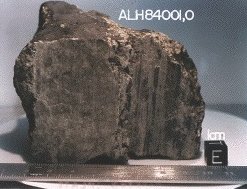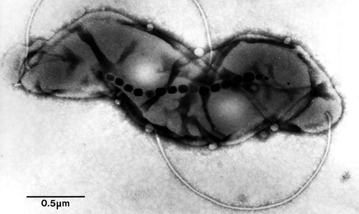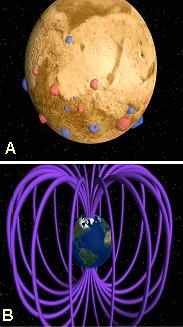|
The Allan Hills meteorite from Mars
is peppered with tiny magnetic crystals that on our planet are made
only by bacteria.
by Patrick L.Barry
The case for ancient life on Mars looks
better than ever after scientists announced that they had discovered
magnetic crystals inside a Martian meteorite -- crystals that, here
on Earth, are produced only by microscopic life forms.
The magnetic compound, called magnetite
or Fe3O4, is common enough on our planet.
It is present, for example, in household video and audio tapes.
But only certain types of terrestrial bacteria, which can assemble
the crystals atom by atom, produce magnetite structures that are
chemically pure and free from defects.
Scientists studying the Allan Hills
meteorite, a 4-billion-year-old rock from Mars that landed in Antarctica
about 13,000 years ago, found just such crystals deep inside the
space rock.
"Finding this type of magnetic crystal
in any material from another planet is an amazing and important
finding," said Dr. Dennis Bazylinski, a geobiologist at Iowa State
University. Bazylinski leads one of the few labs capable of culturing
these magnet-producing bacteria, which are common in many freshwater
and marine environments on Earth.
Bazylinski was one of nine researchers
conducting the four-year investigation, which was funded by NASA's
Astrobiology Institute. A report of their research is in the December
2000 issue of the journal Geochimica et Cosmochimica Acta.
"We're not claiming that this is proof
of life on Mars," said Dr. Everett Gibson, an astrobiologist at
NASA's Johnson Space Center in Houston, Texas, who also participated
in the study.
"What we're claiming is that these
magnetites (from the meteorite) are basically indistinguishable
from certain biogenic (i.e., biologically-produced) magnetites on
Earth. And furthermore, we know of no other mechanism to make them,
either on Earth or Mars," Gibson said.

An
electron microscope image of magnetite crystals from the meteorite.
|
The scientists believe that these crystals
traveled from Mars in the meteorite, rather than being produced
on Earth by bacteria that contaminated the meteorite after it arrived
in Antarctica.
"That was a real concern -- whether
(the magnetite crystals) could be terrestrial contamination," Gibson
said. But several facts support a Martian origin, including the
deep embedding of the crystals in the carbonate material of the
meteorite and the preference of the magnetite-producing bacteria
for low-oxygen environments, making it unlikely that such bacteria
would live where the meteorite was found.
"We looked at it very carefully and convinced
ourselves that the magnetite had to be from Mars," Gibson said. "No
one (in the scientific community) is really questioning that."
This meteorite -- called the Allan
Hills meteorite after the Antarctic ice sheet where it was found
-- is the same one that caused a stir in 1996 by providing the first
potential evidence of bacteria-like life on Mars. These magnetite
crystals were one of the four pieces of evidence from the meteorite
that supported the '96 announcement. But little was known about
the specific traits of bacteria-produced magnetite then.
"At that point, we just knew that there
were tiny magnetite crystals made by bacteria, and we didn't know
much about them," Gibson said. "And we now have studied (the crystals)
in detail, and ones known to be made by bacteria have the same properties
(as those from the meteorite)."
Crystals made by magnetite-producing
bacteria are chemically pure and free from defects in the crystalline
structure. They are slightly elongated along a particular crystalline
axis, and they range in size from 35 to 120 nanometers (a nanometer
is one-billionth of a meter). They also show a particular pattern
of faceting -- like a cut diamond. These properties are so unusual
that they have only been seen in magnetite crystals produced by
biological processes.

The Allan
Hills Meteorite
|
The researchers discovered that about
one-fourth of the magnetite crystals in the meteorite have these
exact properties. The other three-fourths of the crystals are assumed
to have formed geologically, researchers said.
Bacteria are able to make such precise
crystals because they control the construction of the crystal at
an atomic level.
"The magnetites are grown atom by atom
inside the bacteria. The bacteria form a little membrane around
the crystal that controls the growth of the magnetite, and then
they pump iron atoms into that membrane and form these crystals
(which consist of iron and oxygen atoms). By carefully controlling
crystal growth with the membrane, the bacteria keep the crystals
from growing in one direction and allow them to grow in another,"
Gibson said.
The direction in which the bacteria
elongate the crystals maximizes the magnetic strength of the magnetite.
The bacteria, which are mostly from the Magnetospirillum
genus, then line up several of these crystals to collectively act
as a bar magnet, which allows the bacteria to align itself with
Earth's magnetic field.

An example
of a magnetite-producing bacterium
Image courtesy of Dr. Dennis Bazylinski
of Iowa State University. |
Why would a bacterium want to line
up with our planet's magnetic field? It turns out that such behavior
can help an aqueous microbe find water with the right mix of oxygen.
Generally, differing concentrations of oxygen in a body of water
are arranged in horizontal layers, like the floors of a building.
Earth's magnetic field lines, in addition to pointing toward the
pole, also make a vertical angle with the ground. These lines provide
a sort of slanted "elevator shaft" that help the bacteria search
the "building's floors," which can be more efficient than an aimless
search.
But such an internal compass would
be of no use to a Martian bacterium unless Mars had a natural magnetic
field like Earth does.

An artist's
concept comparing the present day magnetic fields on Mars
(A) and Earth (B).
|
"When we first wrote the original paper
in '96, it was thought that Mars had never had much of a magnetic
field," Gibson said. "But then the Mars Global Surveyer detected a
very strong remnant magnetism in some of the rocks in the crust of
Mars. ... So it's clear that early on, Mars had a strong magnetic
field, and that's about the time we think these magnetites were formed:
about 3.9 billion years ago."
In contrast, the earliest well-documented
life on Earth dates back to between 3.6 and 3.7 billion years ago,
Gibson said. Both planets formed about 4.5 billion years ago.
"Now we are trying to answer the question
of whether (magnetite-producing) bacteria could have actually lived
on Mars," Bazylinski said. "And we have found certain aspects of
their metabolism which suggest that they might have been able to
do so."
The journal Science has published
research showing evidence of widespread sediment layers on Mars,
which the researchers interpreted to be the product of ancient lakes
that once dotted Mars's surface. Because these lakes may have provided
a habitat for bacteria, this finding supports the possibility that
the bacteria may have existed on Mars, Bazylinski said.
Though the new evidence from the Allan
Hills meteorite does not prove that life once existed on Mars, Gibson
said that, "We think it's evidence that is hard to explain by any
other hypothesis."
|
